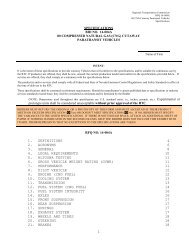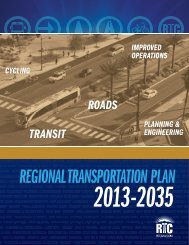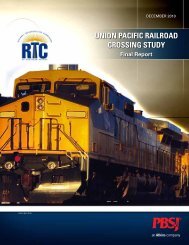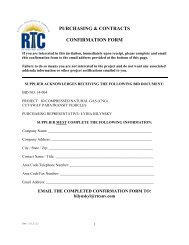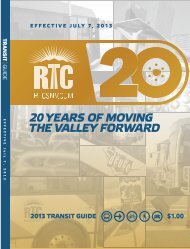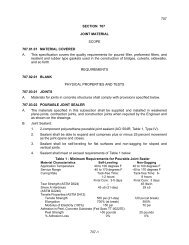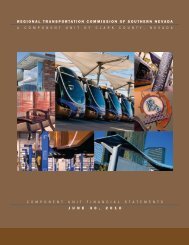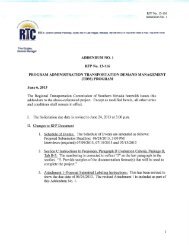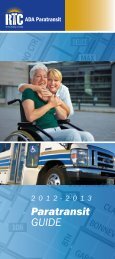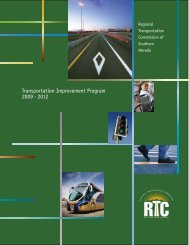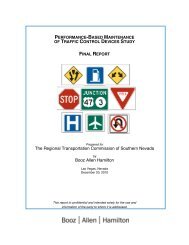(Blue Diamond Road) Corridor Study - Regional Transportation ...
(Blue Diamond Road) Corridor Study - Regional Transportation ...
(Blue Diamond Road) Corridor Study - Regional Transportation ...
Create successful ePaper yourself
Turn your PDF publications into a flip-book with our unique Google optimized e-Paper software.
4. Evaluation Methodology RTC SR-160 <strong>Corridor</strong> <strong>Study</strong><br />
4.0 EVALUATION METHODOLOGY<br />
When assessing the applicability of potential transit investments to specific corridor<br />
segments and developing route structure alternatives, it is important to consider both<br />
potential transit demand and the physical characteristics of the corridor. In developing new<br />
transit services, the basic route network structure is typically influenced by the spatial<br />
distribution of trip generators and attractors and the movement of these trips throughout<br />
the transportation network.<br />
To the extent possible, the route structure should maximize service to identifiable and<br />
predictable commuter and non-work-related trip sheds. Service levels – defined by peak<br />
and non-peak frequencies, span of service, and total vehicle service hours – for these new<br />
routes should correspond with observable transit demand. In the following section, several<br />
key planning variables that help determine the suitability of new transit service to<br />
expanding areas of a regional transportation system are presented.<br />
4.1 FACTORS GUIDING TRANSIT EXPANSION<br />
Planning for transit improvements along the <strong>Blue</strong> <strong>Diamond</strong> corridor merits unique<br />
consideration because the intense pace of new residential development in the Enterprise<br />
area is unprecedented even for the Las Vegas Valley. With so much Major Project<br />
subdivision development currently underway and subsequent phases planned for future<br />
years, the character of the Enterprise community is being transformed from a quiet rural<br />
district to a sprawling suburban area vulnerable to a widening infrastructure gap.<br />
With respect to transportation infrastructure, a multimodal plan for SR-160 and connecting<br />
major arterials that includes a mass transit element must be developed before the window<br />
of opportunity closes – even though there is no transit service there today. The potential to<br />
attract transit ridership is a function of several variables.<br />
<br />
The type and intensity of existing transit service – The type of transit service<br />
already operating in a corridor gives an indication of the relative level of transit<br />
service that a corridor can support. The <strong>Blue</strong> <strong>Diamond</strong> study area does not currently<br />
benefit from any transit service. Given the breakneck pace of subdivision expansion<br />
south of SR-160 and between SR-160 and CC-215, mass transit improvements are<br />
needed, based on future population and development growth estimates and the<br />
changing nature of the community from rural to growing suburban.<br />
<br />
Traffic Volumes and Level of Congestion – High traffic volumes indicate high<br />
demand for travel in specific sections of the transportation network. As Enterprise’s<br />
only east-west connector to I-15, SR-160 is among the region’s most heavily<br />
4-1



